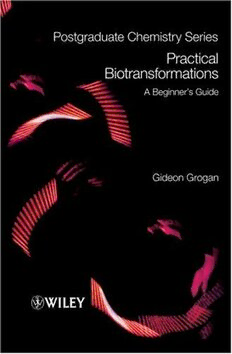
Practical Biotransformations: A Beginner's Guide PDF
353 Pages·2009·4.207 MB·English
Most books are stored in the elastic cloud where traffic is expensive. For this reason, we have a limit on daily download.
Preview Practical Biotransformations: A Beginner's Guide
Description:
Content: Chapter 1: Biotransformations, Microbes and Enzymes. 1.1 Introduction. 1.2 Biotransformations. 1.3 Microorganisms. 1.4 Organism nomenclature. 1.5 Enzymes. 1.6 Types of Enzymatic reactions. 1.7 Enzymatic Cofactors. 1.8 Some Basic Characteristics of Enzyme Catalysis. 1.9 Types of Biocatalyst - Biotransformations by 'whole cells' or isolated enzymes. 1.10. Conclusion. Chapter 2: An overview of biocatalyst sources and web-based information. 2.1 Introduction. 2.2 Microbial culture collections. 2.3 Obtaining organisms from other research groups. 2.4 Selective Enrichments. 2.5 Metagenomics. 2.6 Enzyme Suppliers and Biocatalyst Development Companies. 2.7 Genome mining for biocatalysts. 2.8 Obtaining amino acid and gene sequence information on biocatalysts. 2.9 Obtaining DNA templates for cloning. 2.10 Custom Gene Synthesis. 2.11 Other interesting web resources for biocatalysis. 2.12 Conclusion. Chapter 3: Setting up a laboratory for biotransformations. 3.1 Introduction. 3.2 Microbiological Containment. 3.3 On containment issues and genetically-modified organisms. 3.4 Equipment for handling microorganisms. 3.5 Techniques and terms in microbiology - Sterility, Asepsis and Aseptic Technique. 3.6 Disposal of viable microbial waste and disinfection of reusable equipment. 3.7 Equipment for enzymology and molecular biology. 3.8 General reagents and chemicals in a Biotransformations Laboratory. 3.9 Conclusion. Chapter 4: A beginner's guide to preparative whole-cell microbial biotransformations. 4.1 Introduction. 4.2 Storage, maintenance and growth of microorganisms. 4.3 General Microbiological Methods. 4.4 Examples of Whole-cell Biotransformations using Bacteria. 4.5 Biotransformation by filamentous fungi and yeasts. 4.6 Whole-cell Biotransformations by recombinant strains of E. coli. 4.7 Conclusion. Chapter 5: A beginner's guide to biotransformations by commercially available isolated enzymes. 5.1 Introduction. 5.2 Lipases. 5.3 Hydrolytic Reactions using lipases. 5.4 Using lipases for acylation reactions. 5.5 Other hydrolases. 5.6 Commercially available Coenzyme-dependent Enzymes. 5.7 Carbon-carbon bond forming reactions. 5.8 Conclusion. Chapter 6: A beginner's guide to the isolation and analysis and use of home-grown enzyme biocatalysts. 6.1 Introduction. 6.2 Cell growth and harvesting. 6.3 Cell disruption. 6.4 A typical procedure for making a cell extract from a recombinant strain of E. coli. 6.5 Purification of enzymes - a brief guide. 6.6 Techniques for Protein Purification. 6.7 Isolation of recombinant enzymes using histidine tags. 6.8 Estimation of protein concentration. 6.9 Concentrating protein samples by centrifugation. 6.10 Analysis of protein samples by sodium dodecylsulfate polyacrylamide gel electrophoresis (SDS-PAGE). 6.11 Examples of enzyme assays. 6.12 Using home-grown enzymes for biotransformations ? Some recent examples. 6.13 Conclusion. Chapter 7: An introduction to basic gene cloning for the production of designer biocatalysts. 7.1 Introduction. 7.2 Background to gene cloning. 7.3 Gene amplification by polymerase chain reaction (PCR). 7.4 DNA fragment analysis by agarose electrophoresis. 7.5 Gene cloning. 7.6 Analysis by DNA sequencing. 7.7 Troubleshooting the gene amplification and cloning process. 7.8 Ligation-Independent Cloning. 7.9 Gene Expression in E. coli. 7.10 Conclusion. Chapter 8: Engineering Enzymes. 8.1 Introduction. 8.2 Site-directed or targted mutagenesis as a tool for investigating enzyme mechanism or altering catalytic attributes. 8.3 A site-directed mutagenesis experiment. Considerations and practise. 8.4 Engineering using random mutagenesis. Directed Evolution of Enzymes. 8.5 Combining rational and random mutagenesis for biocatalyst improvement. 8.6 Exploiting catalytic promiscuity for creating new enzyme activities. 8.7 Designing enzymes in silico. 8.8 Conclusion. Appendices. 1. Structures of the proteinogenic amino acids. 2. Structures of bases found in nucleic acids. 3. The Genetic Code. 4. Recipes for Microbiological Growth Media. 5. Biological buffers. 6. Ammonium sulphate fractionation table. 7. Restriction enzymes and restriction sites
See more
The list of books you might like
Most books are stored in the elastic cloud where traffic is expensive. For this reason, we have a limit on daily download.
